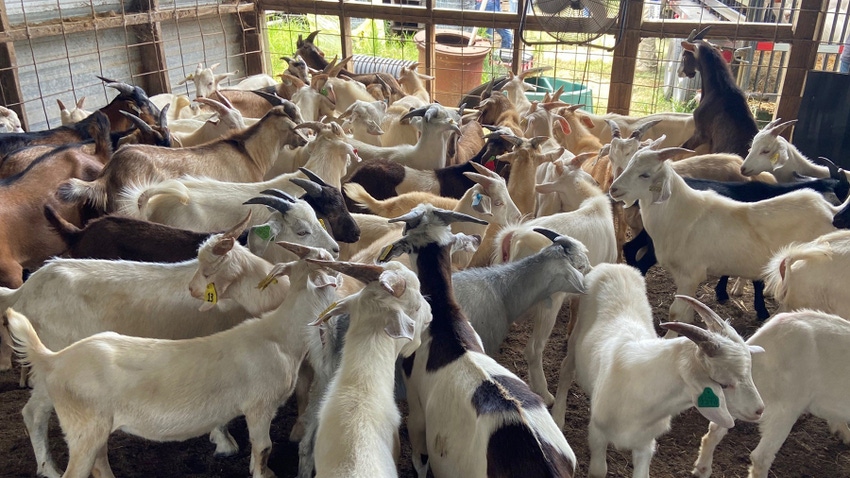September 7, 2023

Most goat meat sold in the U.S. is imported, but a group of Mississippi meat goat producers wants to see that change.
A first-of-its-kind test in the state is underway to help them meet that goal. The Southeastern Buck Performance Test aims to improve the profitability of the meat goat industry in the region by improving meat goat genetics.
The test is being supervised by the Mississippi State University Extension Service and led by Kiko meat goat producers across the country. It is being conducted on the commercial goat farm of Dewayne Smith in Leakesville. Although the test is open to any meat goat breed, Kiko is the predominant breed among southeastern U.S. producers because of its performance in the climate.
Leyla Rios, Extension small ruminant specialist, is coordinating and overseeing the test. She said this study is the first step toward helping current and prospective Mississippi producers improve their herds and, as a result, create a strong market for their products. The study will also help other producers in the region.
“With this test, we will hopefully be able to one day help meet the demand for goat meat in the U.S. with domestic product,” said Rios, who is also an assistant professor in the Department of Animal and Dairy Sciences. “That means more people coming into this business will have a place for whatever goat product they produce -- meat, special cuts, patties, sausages, jerky, and others.”
Three goals
The test has three primary goals: to help identify genetics that produce a salable carcass by feeding forages commonly available in the region; to help improve resistance or resilience to internal parasites, which is the No. 1 challenge for goat producers in Mississippi; and to determine what studies should be included in future tests that can help producers improve production efficiency and profitability.
While tests like these have been performed in several other states for many years, Mississippi producers knew it was important to have tests performed in Mississippi’s climate.
“There has been a test for years in eastern Oklahoma that does give decent parasite management information for Mississippi producers,” said Jeff Lamote, a longtime Alabama goat farmer and member of the test committee. “But eastern Oklahoma’s environment is a totally different environment than south Mississippi. Having data from tests performed where the animals are grown is very beneficial.
“Tests like these are what made our beef, swine and poultry industries what they are today. We don’t import those. We export them,” he said.
Rios, who has been working with goat farmers at their request for two years to build the test team, agreed.
Breed performance
“Studying the performance of bucks in real farming conditions is the only way to improve the breed in local conditions and stop depending on imported semen to improve performance,” she said.
Lamote said the committee wanted to measure four main factors: fecal egg count, average daily weight gain, muscle thickness and USDA grading.
“These are the four factors that drive profit for producers,” Lamote said. “First, you must have a healthy animal, and parasite resistance is one of the most important issues there. Second, you want to have an animal that can reach the proper weight and muscle to get a USDA prime grading.”
The forage test in the study will help determine which bucks perform the best on a forage-only diet. Forages make up 70% to 90% of a small ruminant’s typical diet, depending on quality. Commercial grain mixes make up the remaining 10% to 30%.
“As a producer, anything you can do to lower your input costs helps increase your profit,” Lamote said. “We want to learn how to turn low-cost forage into market value. If you have to buy a lot of feed, that cuts into your profit.”
Feasible livestock
The committee’s ultimate goal is to make meat goats a more feasible livestock animal for small farmers.
“There is a lot of opportunity in goats for small farmers who have less than 50 acres of land,” Lamote said. “There is a lot of land in Mississippi that is not suitable for row crops. There also are a lot of landowners who don’t have enough land for a profitable cattle operation. But that land is great to raise goats.”
The MSU test team consists of Rios; Pearl River County Extension agent Alex Shook; animal and dairy science students Nicholas Merchant, Jill DeGayner and Kelsey Mazeres; animal and dairy science research professor and sonographer Rhonda Vann; Extension forages specialist Rocky Lemus; and animal and dairy science associate professor of genetics Trent Smith. The team also includes experienced Mississippi and Alabama goat farmers Dewayne Smith, Darryl Byrd, Joe Knetter and Lamote.
The MSU team visits the test site once every two weeks during the study to gather data. The test runs from June 26 to Oct. 15. The data gathered in the test will help growers improve their herds within one to two years.
“The fastest way to improve your herd is with a herd sire. Most producers will see improvement in their herds in the first year after they add a buck with the specific traits they are looking for,” Lamote said. “The four measurements we are testing for are all very heritable traits. Nothing is ever 100%, but all these traits have a high rate of heritability.”
Source: Mississippi State University Extension
About the Author(s)
You May Also Like






